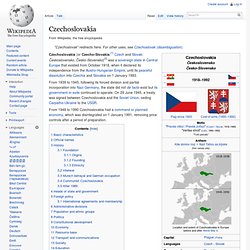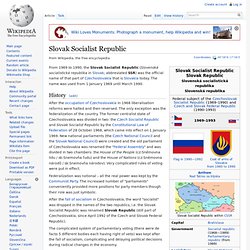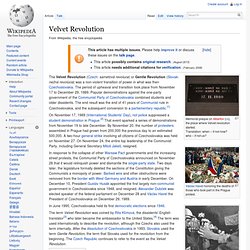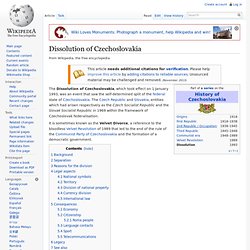

Slovakia Travel Notes. Short URL: - National Anthem of Slovakia.

Slovakia, formerly a part of Czechoslovakia, became an independent republic on January 1st, 1993. Slovakia Travel Brochures. Quick Links. Slovakia. The Slovak Republic (or, in short form, Slovakia i/sloʊˈvɑːkiə/ or /sləˈvækiə/; Slovak: Slovensko (Slovak pronunciation: [ˈslovɛnsko] ( )), long form Slovenská republika (Slovak pronunciation: [ˈslovɛnskaː ˈrɛpublɪka] ( ))) is a landlocked state in Central Europe.[6][7] It has a population of over five million and an area of about 49,000 square kilometres (19,000 sq mi).

Czechoslovakia. Czechoslovakia (or Czecho-Slovakia;[1] Czech and Slovak: Československo, Česko-Slovensko)[2] was a sovereign state in Central Europe that existed from October 1918, when it declared its independence from the Austro-Hungarian Empire, until its peaceful dissolution into Czechia and Slovakia on 1 January 1993.

From 1939 to 1945, following its forced division and partial incorporation into Nazi Germany, the state did not de facto exist but its government-in-exile continued to operate. On 29 June 1945, a treaty was signed between Czechoslovakia and the Soviet Union, ceding Carpatho-Ukraine to the USSR. From 1948 to 1990 Czechoslovakia had a command or planned economy, which was disintegrated on 1 January 1991, removing price controls after a period of preparation. Basic characteristics[edit] Slovak Republic (1939–45) Postage stamps of Slovakia, including a stamp of Czechoslovakia with an overprint reading "Slovak State 1939".

Territorial changes of Slovak Republic from 1938 to 1947 (Red indicating areas with a Hungarian majority. Changes on border with Poland are missing). Slovak Socialist Republic. From 1969 to 1990, the Slovak Socialist Republic (Slovenská socialistická republika in Slovak; abbreviated SSR) was the official name of that part of Czechoslovakia that is Slovakia today.

The name was used from 1 January 1969 until March 1990. History[edit] Federalization was notional – all the real power was kept by the Communist Party. The increased number of "parliaments" conveniently provided more positions for party members though their role was just symbolic. Velvet Revolution. Memorial plaque on Albertov (cs), the place where Velvet revolution started.

Translation: when – if not now? Who – if not us? Václav Havel honoring the deaths of those who took part in the Prague protest. Non-violent protesters facing armed policemen with flowers The Velvet Revolution (Czech: sametová revoluce) or Gentle Revolution (Slovak: nežná revolúcia) was a non-violent transition of power in what was then Czechoslovakia. On November 17, 1989 (International Students' Day), riot police suppressed a student demonstration in Prague.[2] That event sparked a series of demonstrations from November 19 to late December.
In response to the collapse of other Warsaw Pact governments and the increasing street protests, the Communist Party of Czechoslovakia announced on November 28 that it would relinquish power and dismantle the single-party state. In June 1990, Czechoslovakia held its first democratic elections since 1946. Dissolution of Czechoslovakia. The Dissolution of Czechoslovakia, which took effect on 1 January 1993, was an event that saw the self-determined split of the federal state of Czechoslovakia.

The Czech Republic and Slovakia, entities which had arisen respectively as the Czech Socialist Republic and the Slovak Socialist Republic in 1969 within the framework of Czechoslovak federalisation. It is sometimes known as the Velvet Divorce, a reference to the bloodless Velvet Revolution of 1989 that led to the end of the rule of the Communist Party of Czechoslovakia and the formation of a democratic government.
Background[edit] Czechoslovakia was created with the dissolution of Austria-Hungary at the end of World War I. In 1917, a meeting took place in Pittsburgh, Pennsylvania, where the future Czechoslovak president Tomáš Garrigue Masaryk and other Czech and Slovak representatives signed the Pittsburgh Agreement which promised a common state consisting of two equal nations, Slovakia and Czechia. Separation[edit] Territory[edit] The History of the Czech Republic and Slovakia - William M. Mahoney. History of Slovak Literature - Peter Petro.
The Slovak Republic: A Decade of Independence, 1993-2002. Slovakia: The Heart of Europe - Ol̕ga Drobná, Eduard Drobný, Magdalena Gocnikova. Slovakia - Lucy Mallows.